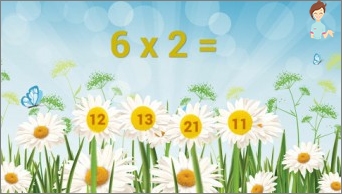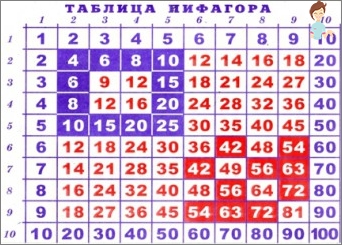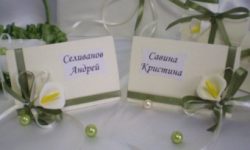We help the child to learn the multiplication table
How to learn the multiplication table – this question often occurs in children of younger students. We offer you some uncomplicated ways
Sooner or later, every child of preschool age grows, and, having taking a school bench, he has to cope with such a difficult task, as learning the multiplication table. In order to be able to do it as soon as possible, the parents should help in this.
Methods to help memorize
 Today in the Internet network there are a large number of methods with which the student absorbs the Pythagore table very quickly.
Today in the Internet network there are a large number of methods with which the student absorbs the Pythagore table very quickly.
It can be:
- games;
- poems;
- programs;
- cards;
- songs;
- Video and audio.
Due to this variety of methods, you can find an individual approach to each student by choosing the most effective technique. Let’s look at the main techniques and methods of studying the Pythagora sign, among which you can choose the most suitable and effective way for your child.
When finding out the Pythagore table, you need to explain the chad that the number from the left column must be multiplied by the number from the top line, and on their intersection and you need to look for the answer.
First of all, it is very important to give to understand how the plate is arranged and the essence of its action. Getting Studying Platek Children, as a rule, already have an idea of elementary arithmetic acts, such as addition and subtraction. Thanks to this basis, the student is easier to explain the principle of multiplication table and learn it.
For example, in order to multiply by 3, the number 2 must be folded three times. If the student understands this simple principle, then he will be able to avoid difficulties and misunderstanding in the future.
Study of the Pythagore table in the form of the game
The game is an easy way to study not only multiplication signs. All actions that are performed in the game form are remembered much better. If a child has an interest in her study, you can be sure that half of the case is done.
One of the most famous games with a sign is considered to be a game of cards. The essence of this game is that the student in random takes out a card from a common stack and sees an example of a work without an answer. If he can give the correct answer, then the card drops out of the game. And if the answer is not found, the card again returns to the total stack, and maybe again stretched out.
The game can continue until all the cards are running out, that is, until the right answers to all questions. This game is still wearing name «training apparatus». To start to play it in stages, depending on the learned material. Starting with signs on «2», gradually adding new examples.
From simple to complex

In order for the child to be easy to assimilate the new material, it is necessary to start with the simplest, leading examples from the plate that it can very easily solve.
Multiplication by «one» As a result, always gives the same number that must be multiplied. For example: 1 * 1 = 1, 2 * 1 = 2 and so on. Similarly, 10 is the same number, only you need to attribute to it. For example: 1 * 10 = 10 and 2 * 10 = 20. When a child is working, he will need to explain that now he knows all the extreme columns and lines in the table.
If the explanation of this material has taken away a lot of time, and the student is tired, then you need to give it a rest and transfer the remaining study of the Pythagore sign the next time.
Multiplication sign by «2» usually learn very easily, as this is the usual addition of two numbers. If you have begun to study Pythagora’s sign, most likely, the child can already be quite well to fold small values and it will not cause problems.
Studying the Pythagore table you need to consider and assimilate such a simple law as a change of multipliers. He says that even when the multipliers are rearranged, the work remains the same. That is, learning the multiplication table is easier if you know that 2 * 3 is the same as 3 * 2.
The second string and the second column contain the same numbers as the third line in the third column. Accordingly, after absorption of the work of 2 per any numbers, the multiplication of the remaining numbers on 2 will also be known. As a result, the task becomes even simpler!
Multiplication Table in verses
An effective way of assimilating the plate is the use of poetic form. In the event of difficulties when memorizing a child, poems are interesting way. Perhaps words in rhyme will be much easier to memorize than just numbers.
Today it is possible to familiarize yourself with a large number of poems with a pythagoronic table, with examples of multiplication of 7 * 8, which very often cause difficulties.
Multiplication Table on Fingers
The plate has some examples that simply calculate using the fingers. This is related not only to the simplest works, but also to a difficult work on «nine». To do this, you need to put hands next to each other, and straighten your fingers.
After that, in order to get a product of any number on «nine» You just need to get a finger, under the number of this number, starting the countdown on the left. The number of fingers to the curved number is dozens of response, and after – units.
Targeted memorization
After assimilation of simple examples, you can proceed to the study of more complex multipliers. It is important to use the elements of the game and other useful memorization methods as associations, fragmentation on the part, check tasks and the use of examples in practice.
Some of them need to be memorable and repeatedly repeat so that the student can easily list all the meanings. No need to hurry! It is better to move from one digit to another, and do not try to learn everything in one moment. It is better to start with multiplication by 2, 3 and 4, gradually moving to subsequent numbers.
Some teachers practice studying it starting with «nine», that is, with more complex examples, gradually moving to a simpler. But it is better not to do so that the child does not have stress from the misunderstanding of how these numbers turned out.
For example, when multiplying the value of 3 * 3, the student is able to test himself on the fingers and find the correct answer, and if it is suggested an example of the work of 9 * 9 and say that the answer needs to be simply remember, he will not be able to use the knowledge gained in practice, which can adversely affect the subsequent memorization and his motivation.
The first difficulties may occur when studying the table on «3». In this case, in the event of difficulties with memorization, it is best to use cards. If Chad has a humanitarian mindset, then you can use verses to memorize the sign.
To explore the work on «4» You can also use cards and poems. As a prompt, you need to understand the student that multiplying «4» – this is the same as multiplication on «2» And once again on «2». These arithmetic patterns are also useful to know for the development of an oral account.
 Table by «five» is usually just. The child digested very quickly that all values are in 5 units from each other and ends at 5 or 0. So Table Pythagora on 6, 7, 8 and 9 is also studied simply, after learning the previous values. In order to visually it looked simply, the values already mastered at this point are highlighted in green.
Table by «five» is usually just. The child digested very quickly that all values are in 5 units from each other and ends at 5 or 0. So Table Pythagora on 6, 7, 8 and 9 is also studied simply, after learning the previous values. In order to visually it looked simply, the values already mastered at this point are highlighted in green.
Examples from practice
Learn any mathematical work easier if you translate it to a practical example. For example, how much need wheels for 5 cars. Since each car has 4 wheels, it means that 5 must be multiplied by 4. Resulting in 20. Or, how much is the elastic band, to braid two pigtails with two dolls. 2 * 2 = 4.
That’s all! Now you know how to learn the multiplication table with a child easily and quickly. Apply them in practice, and your child quickly and easily master the multiplication plate!


